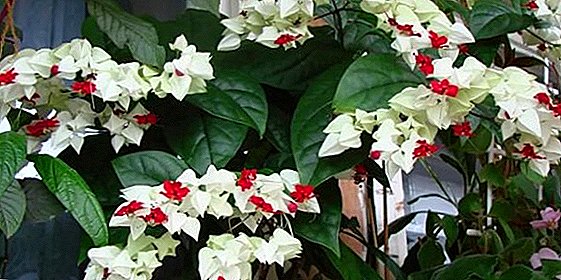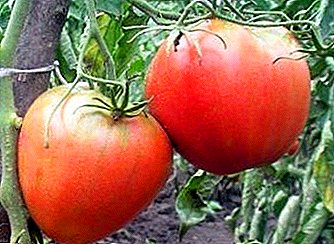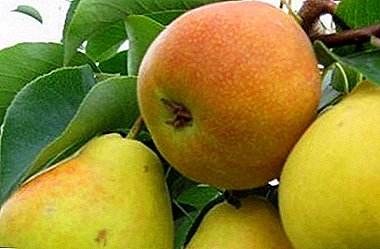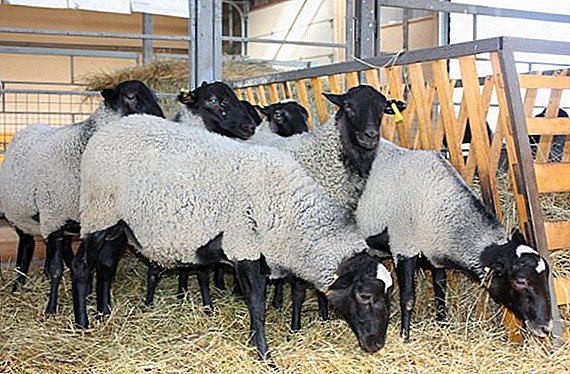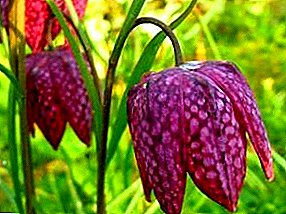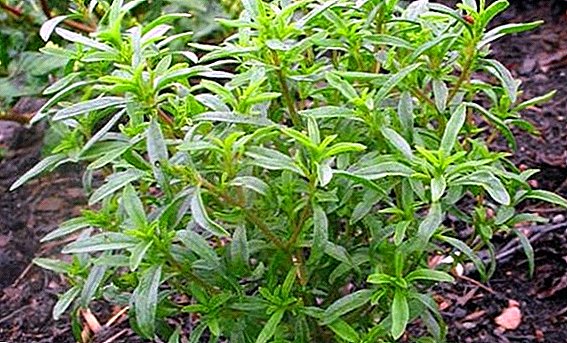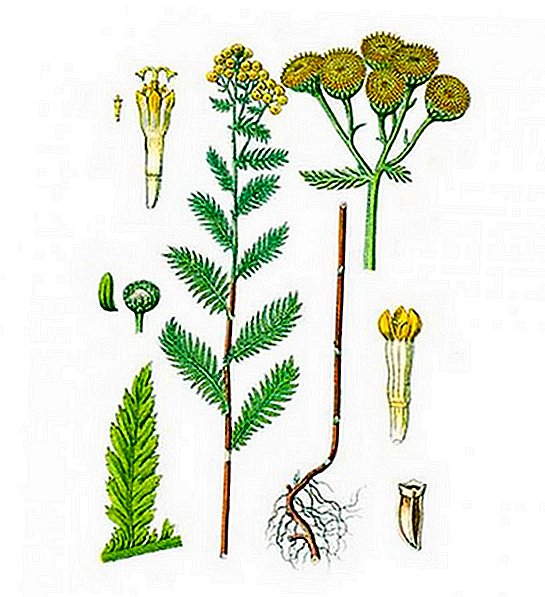
Oil-bearing radish is a honey-bearing and forage plant, often used as a natural fertilizer. The region of origin is Asia, where the radish has long been distributed as a vegetable.
Currently, the plant is not found in the wild, but is cultivated in large quantities in North America and Europe.
The article tells about the beneficial properties of this plant, its use in cooking, animal husbandry, cosmetology and other areas, as well as how to grow oilseed radish.
What is it?
Radish oilseed - herbaceous plant, one-year, belongs to the cruciferous family. The foliage is bright green, the shoots are powerful and branched, can reach two meters in height. The leaves have a very original, rugged shape, and the fruit, unlike the closest relative, is a radish, not a root crop, but a pod with seeds. Small flowers may have a different color: white, lilac, pink.
A photo
You will see a photo of the seeds of this vegetable and himself:




Chemical composition
The oil content in oilseed radish seeds reaches 39-50%, moisture 11.5%, fiber 8.3%, protein 23.9%.
The composition of the oil includes several types of acids., such as:
- palmitic;
- stearic;
- arachin;
- behenova;
- erucate;
- oleic;
- linoleic;
- linolenic.
In addition to fatty oils, radish seeds contain essential oils. A large amount of culture contains:
- phosphorus;
- potassium;
- calcium;
- magnesium;
- zinc;
- iron.
Salad variety can be used as a source:
- vegetable protein;
- carotene;
- vitamin C;
- antioxidants.
The leaves contain about 3 grams. squirrel, 6 gr. carbohydrates, and their caloric content is 30 kcal per 100 grams.
Attention! Lettuce radish leaves are able to accumulate nitrates, so when growing it should not use chicken droppings or fresh manure. It is best to apply a complex mineral fertilizer!
What is it used for?
Perfect siderat
 Perfectly improves poor, depleted, clay soil. If the land is intensively exploited, it is often not enough even to use complex mineral fertilizers. In this case, natural fertilizers will be invaluable.
Perfectly improves poor, depleted, clay soil. If the land is intensively exploited, it is often not enough even to use complex mineral fertilizers. In this case, natural fertilizers will be invaluable.
Siderates, which include oilseed radish, are a source of nutrients for the main crops, their use is necessary for the health of the soil during rapid crop rotation. Thanks to a powerful root system, oilseed radish loosens even the most dense soil with a high clay content, transfers hard-to-reach nutrients from the deep layers of the soil to the upper ones, which is why its fertility is growing rapidly.
This plant is effective in protecting soil from erosion. - leaching of nutrients by rain and wind. If you do not remove the plants for the winter, they will trap the snow and the soil in the spring will be saturated with melt water.
Due to the content of a number of essential oils, oil radish perfectly relieves the soil from the wireworm, a number of fungal diseases, such as potato scab and rhizoctoniosis, which causes an indelible black "dirt" on the peel.
Dense foliage inhibits the growth and development of weeds, especially wheatgrass. After mowing, the radish plant serves as a breeding ground for earthworms and beneficial microorganisms.
Forage plant
The two main advantages of this variety of forage crops are early maturity and high yield. Also, thanks to unpretentiousness in cultivation and resistance to frosts, the cultivation of oil radish allows you to walk animals to pasture until late autumn.
Radish is nutritious, rich in protein, gives a lot of green mass, which can be given to cattle both fresh and as silage, grass meal, briquettes. For feed it is better to plant with legumes, cereals and sunflower.
Medonos
Due to the long flowering period, oilseed radish is an excellent honey plant. Even in the cool season, the flowers of this plant are able to produce nectar and attract bees. Honey has a very pleasant smell and thickens very quickly, so it is not recommended to leave it for the winter in honeycombs.
In cooking
 There are special types of oilseed radish, imported to Russia from South Korea. They feel great in the cool season, which allows them to grow from early spring to late autumn.
There are special types of oilseed radish, imported to Russia from South Korea. They feel great in the cool season, which allows them to grow from early spring to late autumn.
Leaves after flowering lose their value, so that they should be used for food before flowering, usually 4-5 weeks after planting.
The classic recipe for vitamin radish salad includes:
- 3-4 small plants (cut off the stems at a distance of about 3 cm from the ground);
- cucumber;
- spring onions;
- vegetable oil;
- salt.
In pharmacology
In pharmacology, essential oils and essences are used to produce vitamin complexes. also often oil radish is included in the composition of herbal.
Note! This tea perfectly relieves stress, eliminates headaches.
In cosmetology
Essential emulsion of radish made to add to the composition of massage oils. Such oils have a slight warming effect and promote relaxation. Balsams and conditioners with essential rare oil give the hair a pleasant honey smell and facilitate combing.
Shrovetide vegetable or mustard - which is better?
Mustard, along with oilseed radish, is the most popular siderat. Both plants belong to the cruciferous family, therefore they are similar in functionality - they perfectly prepare the ground for:
- potatoes;
- tomatoes;
- squash;
- cucumbers;
- sweet pepper.
Mustard also can not be grown as a precursor of cabbage. The main difference of vegetables is their use on different types of soil: so, white mustard is extremely unwell in acidic, marshy areas. The radish is undemanding, it copes even with the heaviest soil.
Where to buy planting material?
Seeds can be bought in almost any specialized or online store for gardeners. Also in Moscow, St. Petersburg and other major cities, this product is offered by large retail chains, such as:
- OBI;
- Maxid;
- Auchan;
- Okay;
- Tape.
Seeds are inexpensive, their cost is approximately 50-70 rubles per kilogram.
When to sow?
 When plant shrovetide vegetable? It depends on the purpose of the site owner. Landing can be made from April to mid-September.
When plant shrovetide vegetable? It depends on the purpose of the site owner. Landing can be made from April to mid-September.
Early sowing oilseed vegetables are used as a green manure and for animal feed. The richest crop of seeds planted in April. Late crops serve to prepare the soil for spring planting, in particular, to hold the snow and further saturate the soil with melt water, as well as to protect the soil from excessive freezing.
Landing time depends on the climate zone. - it is not worth sowing in the frozen soil, the snow should go completely.
The last sowing is better to make approximately 40 days before frost. With sufficient moisture, oil-bearing radish can be successfully grown in areas of high-risk farming.
Seed consumption
The seeding rate per one hundred parts - 200-400 grams, on 1 hectare consumption is 8-16 kilograms of seeds. They are planted for cattle feed, for seed seeding it will take less. The later the sowing is done, the greater the consumption of seeds, after mid-August, the seeding rate doubles.
Step by step instructions on how to plant in the ground
The land must first be loosened, deep digging is not required. Perfect cultivator or ploskorez Fokin. It is advisable to land on a cool, rainy day. When planting in heat, the productivity of seeds may be halved. The sowing depth is 2-4 centimeters, the distance between the rows is 0, 15 meters - if the purpose of sowing is green manure or growing feed for livestock, 40 cm - if planting is for honey collection or seed production.
For convenience, sowing seeds can be mixed with coarse sand, commercially used seeder CH-16.
We offer to watch a video on how to plant oilseed radish on your site:
Cultivation technology
The first shoots will appear on the 4-5 day, in the cold season - on the 9-10 day. Best developed in warm weather, subject to high humidity. Therefore, oil radish needs intensive watering. Also, oil radish for optimal development need the sun.
On sod-podzolic soils, the crop needs fertilizer, for this, lime and ash are introduced into the upper layer, as well as mineral complexes that enrich the soil with nitrogen, phosphorus and potassium.
Important! It is necessary to mow the green mass in time, since the woodiness of the plant stems will make it impossible to use it as feed for livestock!
Mowing
- For fodder purposes, mowing is done before flowering begins - this is approximately 40-45 days after sowing.
- For green winterization - 3 weeks before planting.
- With health-improving cultivation - two weeks before the onset of frost.
The cutting height at the first mowing should not be less than 6-8 centimeters, otherwise, there will be no intensive growth afterwards.
For full fermentation and the formation of natural organic fertilizer from green mass it is necessary that the soil was wet!
Diseases and pests
The main enemy of this culture is cruciferous flea. In case of their occurrence, the crops are treated with chemical preparations; a pretreatment of TMTD seeds (thiram 400 g / l) also gives a good effect.
Alternative
 Along with oilseed radish, excellent sideratami for garden and vegetable garden are:
Along with oilseed radish, excellent sideratami for garden and vegetable garden are:
- mustard;
- spring rape;
- buckwheat;
- rye;
- oats;
- wheat;
- lupine.
If the area of the beds is small, Early ripening varieties of ordinary radish can be a good alternative:
- Odessa 5;
- Green goddess;
- May;
- Sudarushka.
Having planted them in March, it is possible to reap a crop of tasty root crops already after 30-60 days and to release a bed for cucumbers and tomatoes. The plant will be an excellent fertilizer.
In Russia, you can buy seeds of radish oilseed popular varieties:
- Sabina;
- Nika;
- Prygazhunya;
- Brutus;
- Rainbow;
- Tambovchanka.



